Related Research Articles

Amber is fossilized tree resin that has been appreciated for its color and natural beauty since Neolithic times. Much valued from antiquity to the present as a gemstone, amber is made into a variety of decorative objects. Amber is used in jewelry. It has also been used as a healing agent in folk medicine.

Gracillariidae is an important family of insects in the order Lepidoptera and the principal family of leaf miners that includes several economic, horticultural or recently invasive pest species such as the horse-chestnut leaf miner, Cameraria ohridella.

Archaeidae, also known as assassin spiders and pelican spiders, is a spider family with about ninety described species in five genera. It contains small spiders, ranging from 2 to 8 millimetres long, that prey exclusively on other spiders. They are unusual in that they have "necks", ranging from long and slender to short and fat. The name "pelican spider" refers to these elongated jaws and necks used to catch their prey. Living species of Archaeidae occur in South Africa, Madagascar and Australia, with the sister family Mecysmaucheniidae occurring in southern South America and New Zealand.

Hydrocenidae is a taxonomic family of minute land snails or cave snails with an operculum, terrestrial gastropod mollusks or micromollusks in the clade Cycloneritimorpha.
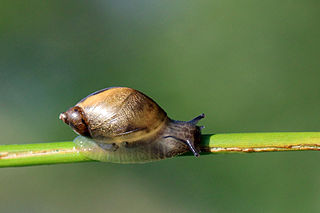
Succinea putris is a species of small air-breathing land snail in the family Succineidae, the amber snails.
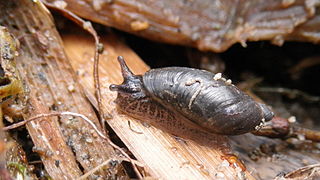
Oxyloma elegans is a species of small European land snail, a terrestrial pulmonate gastropod mollusk belonging to the family Succineidae, the amber snails.

Vertiginidae, common name the whorl snails, is a family of minute, air-breathing land snails, terrestrial pulmonate gastropod molluscs or micromollusks in the superfamily Pupilloidea.

Zonitidae, common name the true glass snails, are a family of mostly rather small, air-breathing land snails, terrestrial pulmonate gastropod mollusks in the superfamily Zonitoidea.
Boninosuccinea is a genus of air-breathing land snails, terrestrial gastropod mollusks in the family Succineidae, the amber snails.
Ptychalaea is a fossil genus of very small, air-breathing land snails, terrestrial pulmonate gastropod molluscs in the family Gastrocoptidae.
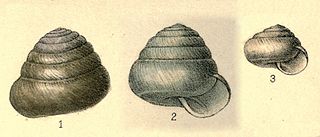
Sagdidae is a family of air-breathing land snails, terrestrial pulmonate gastropod mollusks with highest diversity in the Greater Antilles. It has been classified in its own superfamily Sagdoidea and as a member of the superfamily Helicoidea. Some species of Sagdidae are ovoviviparous.
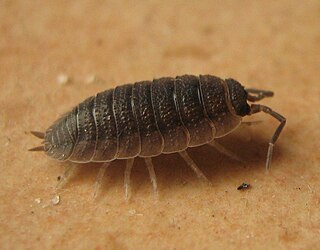
Porcellio is a genus of woodlice in the family Porcellionidae. These crustaceans are found essentially worldwide. A well-known species is the common rough woodlouse, Porcellio scaber.
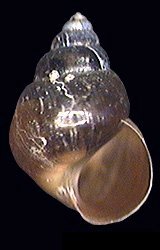
Assimineidae is a family of minute snails with an operculum, gastropod mollusks or micromollusks in the superfamily Rissoidae. Many of these very small snails live in intermediate habitats, being amphibious between saltwater and land; others live in freshwater.

The Baltic region is home to the largest known deposit of amber, called Baltic amber or succinite. It dates from 44 million years ago. It has been estimated that these forests created more than 100,000 tons of amber. Today, more than 90% of the world's amber comes from Kaliningrad Oblast of Russia. It is a major source of income for the region; the local Kaliningrad Amber Combine extracted 250 tonnes of it in 2014, 400 tonnes in 2015.

Atelestidae is a family of true flies in the superfamily Empidoidea. The four genera were placed in a separate family in 1983; they were formerly either in Platypezidae or considered incertae sedis. While they are doubtless the most basal of the living Empidoidea, the monophyly of the family is not fully proven. The genus Nemedina seems to represent a most ancient lineage among the entire superfamily, while Meghyperus is probably not monophyletic in its present delimitation, and it is liable to be split up eventually, with some species being placed elsewhere. In 2010, the genus Alavesia, previously only known from Cretaceous fossils, was found alive in Namibia, subsequent species were also described from Brazil.

Yantaromyrmex is an extinct genus of ants first described in 2013. Members of this genus are in the subfamily Dolichoderinae of the family Formicidae, known from Middle Eocene to Early Oligocene fossils found in Europe. The genus currently contains five described species, Y. constrictus, Y. geinitzi, Y. intermedius, Y. mayrianum and Y. samlandicus. The first specimens were collected in 1868 and studied by Austrian entomologist Gustav Mayr, who originally placed the fossils in other ant genera until the fossils were reviewed and subsequently placed into their own genus. These ants are small, measuring from 4 to 6 mm in length and can be characterized by their trapezoidal shaped head-capsules and oval compound eyes that are located slightly to the rear of the capsules midpoint, with no known ocelli present.
Taphioporus is an extinct genus of leaf beetles in the subfamily Eumolpinae. It is known from Baltic and Rovno amber from the upper Eocene.

Gastrocoptidae is a family of minute, air-breathing land snails, terrestrial pulmonate gastropod molluscs in the superfamily Pupilloidea.
Balticopta is a fossil genus of minute air-breathing land snails, terrestrial pulmonate gastropod molluscs in the family Gastrocoptidae from Eocene Baltic amber. It includes one species, B. gusakovi.
Euthema is a fossil genus of minute land snails with an operculum, terrestrial gastropod molluscs in the family Diplommatinidae from the Cretaceous Burmese amber.
References
| | This prehistoric gastropod article is a stub. You can help Wikipedia by expanding it. |
| | This Heterobranchia-related article is a stub. You can help Wikipedia by expanding it. |